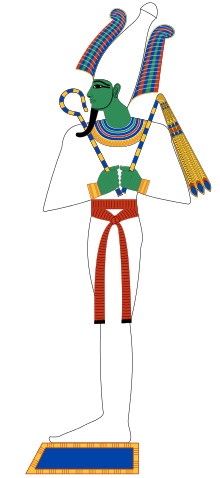
Back Osiris Afrikaans Osiris ALS أوزيريس Arabic اوزيريس ARZ অচাইৰিছ Assamese Osiris AST Osiris Azerbaijani Асірыс Byelorussian Асырыс BE-X-OLD Озирис Bulgarian
| Osiris | ||||
|---|---|---|---|---|
 Osiris, lord of the dead and of rebirth. His green skin symbolizes rebirth. | ||||
| Name in hieroglyphs |
| |||
| Major cult center | Busiris, Abydos | |||
| Symbol | Crook and flail, Atef crown, ostrich feathers, fish, mummy gauze, djed | |||
| Genealogy | ||||
| Parents | Geb and Nut; Ipy[1] | |||
| Siblings | Isis, Set, Nephthys, Heru-ur | |||
| Consort | Isis | |||
| Offspring | Horus, Anubis (in some accounts) | |||
Osiris (/oʊˈsaɪrɪs/, from Egyptian wsjr)[a] was the god of fertility, agriculture, the afterlife, the dead, resurrection, life, and vegetation in ancient Egyptian religion. He was classically depicted as a green-skinned deity with a pharaoh's beard, partially mummy-wrapped at the legs, wearing a distinctive atef crown, and holding a symbolic crook and flail.[5] He was one of the first to be associated with the mummy wrap. When his brother Set cut him up into pieces after killing him, with her sister Nephthys, Osiris' wife, Isis, searched all over Egypt to find each part of Osiris. She collected all but one – Osiris’s genitalia. She then wrapped his body up, enabling him to return to life. Osiris was widely worshipped until the decline of ancient Egyptian religion during the rise of Christianity in the Roman Empire.[6][7]
Osiris was at times considered the eldest son of the earth god Geb[8] and the sky goddess Nut, as well as being brother and husband of Isis, and brother of Set, Nephthys, and Horus the Elder, with Horus the Younger being considered his posthumously begotten son.[8][9] Through syncretism with Iah, he was also a god of the Moon.[10]
Osiris was the judge and lord of the dead and the underworld, the "Lord of Silence"[11] and Khenti-Amentiu, meaning "Foremost of the Westerners".[12] In the Old Kingdom (2686–2181 BC) the pharaoh was considered a son of the sun god Ra who, after his death, ascended to join Ra in the sky. After the spread of the Osiris cult, however, the kings of Egypt were associated with Osiris in death – as Osiris rose from the dead, they would unite with him and inherit eternal life through imitative magic.[13][14]
Through the hope of new life after death, Osiris began to be associated with the cycles in nature, in particular the sprouting of vegetation and the annual flooding of the Nile River, as well as the heliacal rising of Orion and Sirius at the start of the new year.[15] He became the sovereign that granted all life, "He Who is Permanently Benign and Youthful".[15]
The first evidence of the worship of Osiris is from the middle of the Fifth Dynasty of Egypt (25th century BC), although it is likely that he was worshiped much earlier;[16] the Khenti-Amentiu epithet dates to at least the First Dynasty, and was also used as a pharaonic title. Most information available on the Osiris myth is derived from allusions in the Pyramid Texts at the end of the Fifth Dynasty, later New Kingdom source documents such as the Shabaka Stone and "The Contendings of Horus and Seth", and much later, in the narratives of Greek authors including Plutarch[17] and Diodorus Siculus.[18]
Some Egyptologists believe the Osiris mythos may have originated in a former living ruler — possibly a shepherd who lived in Predynastic times (5500–3100 BC) in the Nile Delta, whose beneficial rule led to him being revered as a god. The accoutrements of the shepherd, the crook and the flail – once insignia of the Delta god Andjety, with whom Osiris was associated – support this theory.[13]
- ^ Hart, George (2006-04-21). A Dictionary of Egyptian Gods and Goddesses. Routledge. p. 100. ISBN 978-1-134-93012-8.
- ^ KAI 31, 47 (Cippi of Melqart), 48 (Banobal stele), 91; RÉS 367, 504
- ^ "Coptic Dictionary Online". corpling.uis.georgetown.edu. Retrieved 2017-03-17.
- ^ Allen, James P. (2010). Middle Egyptian: An Introduction to the Language and Culture of Hieroglyphs. Cambridge University Press. ISBN 9781139486354.
- ^ "Egyptian Mythology - Osiris Cult". touregypt.net (in Russian). Retrieved 2018-10-26.
- ^ "Catholic Encyclopedia: Theodosius I". Newadvent.org. 1912-07-01. Retrieved 2012-05-01.
- ^ "History of the Later Roman Empire from the Death of Theodosius I. to the Death of Justinian", The Suppression of Paganism – ch22, p. 371, John Bagnell Bury, Courier Dover Publications, 1958, ISBN 0-486-20399-9
- ^ a b Wilkinson, Richard H. (2003). The Complete Gods and Goddesses of Ancient Egypt. London: Thames & Hudson. p. 105. ISBN 978-0-500-05120-7.
- ^ Kane Chronicles
- ^ Quirke, S.; Spencer, A. J. (1992). The British Museum Book of Ancient Egypt. London: The British Museum Press.
- ^ "The Burden of Egypt", J. A. Wilson, p. 302, University of Chicago Press, 4th imp 1963
- ^ Collier, Mark; Manley, Bill (1998). How to Read Egyptian Hieroglyphs, British Museum Press, p. 41, ISBN 0-7141-1910-5
- ^ a b Strudwick, Helen (2006). The Encyclopedia of Ancient Egypt. New York: Sterling Publishing Co., Inc. pp. 118–119. ISBN 978-1-4351-4654-9.
- ^ "Man, Myth and Magic", Osiris, vol. 5, pp. 2087–2088, S.G.F. Brandon, BPC Publishing, 1971.
- ^ a b Cite error: The named reference
oxfordwas invoked but never defined (see the help page). - ^ Griffiths, John Gwyn (1980). The Origins of Osiris and His Cult. Brill. p. 44
- ^ "Isis and Osiris", Plutarch, translated by Frank Cole Babbitt, 1936, vol. 5 Loeb Classical Library. Penelope.uchicago.edu
- ^ "The Historical Library of Diodorus Siculus", vol. 1, translated by G. Booth, 1814.
Cite error: There are <ref group=lower-alpha> tags or {{efn}} templates on this page, but the references will not show without a {{reflist|group=lower-alpha}} template or {{notelist}} template (see the help page).